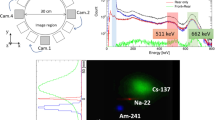Abstract
Aim: A comparative study of the images obtained with a dual-head coincidence gamma camera with thick NaI crystals (19 mm), a dedicated PET camera with BGO crystals and a conventional gamma camera with thin NaI crystals (9.5 mm) was conducted to clarify the clinical feasibility of a dualhead coincidence gamma camera with thick NaI crystals.Methods: FDG images of 27 patients with malignant tumors were obtained by means of a dual-head coincidence gamma camera with thick NaI crystal and a dedicated PET camera with BGO crystals. The images of bone scintigraphy in 10 cancer patients obtained with the dual-head coincidence gamma camera were compared with those taken by a conventional dual-head gamma camera with thin NaI crystals.Results: Patient-basis sensitivity in 27 patients with neoplasms and lesion-basis sensitivity of the dual-head coincidence gamma camera and the dedicated PET camera were 74.1% and 85.2% (n.s.), 66.7% and 72.2% (n.s.), respectively. The tumor to background FDG uptake ratio derived from the coincidence gamma camera was significantly lower than that derived from the dedicated PET camera (mean ±s.d.; 3.48±3.77 vs. 8.12±8.92, p<0.0001), but the tumor to background FDG uptake ratio obtained with both methods correlated well (r=0.84, p <0.001). Similar whole body bone scans were obtained with the dual-head coincidence gamma camera and the conventional dual-head gamma camera in all 10 patients.Conclusion: These results suggest that the dual-head coincidence gamma camera with thick NaI crystals has potentially high clinical applicability for community hospitals.
Similar content being viewed by others
References
Coleman RE. Clinical PET in oncology.Clin Pos Imag 1998: 1: 15–29.
Kim EE, Chung SK, Haynie TP, Kim CG, Cho BJ, Podoloff DA, et al. Differentiation of residual or recurrent tumors from post-treatment changes with F-18 FDG PET.Radiographics 1992; 12: 269–279.
Inoue T, Kim EE, Komaki R, Wong FC, Bassa P, Wong WH, et al. Detecting recurrent or residual lung cancer with FDG-PET.J Nucl Med 1995; 36: 788–793.
Martin WH, Delbeke D, Patton JA, Sandler MP. Detection of malignancies with SPECT versus PET, with 2-[Fluorine-18]fluoro-2-deoxy-d-glucose.Radiology 1996; 198: 225–231.
Macfarlane DJ, Cotton L, Ackermann RJ, Minn H, Ficaro EP, Schreve PD, et al. Triple-head SPECT with 2-[fluorine-18]fluoro-2-deoxy-d-glucose (FDG): initial evaluation in oncology and comparison with FDG PET:Radiology 1995; 194: 425–429.
Muehllehner G, Geagan M, Countryman P, Nellemann P. SPECT scanner with PET coincidence capability. [abstract]J Nucl Med 1995; 36; 70P.
Abdel-Dayem HM, Luo JQ. Clinical experience with dual head gamma camera coincidence imaging.Clin Pos Imag 1999; 2: 31–39.
Shreve PD, Steventon RS, Deteres EC, Kison PV, Gross MD, Wahl RL. Oncologic diagnosis with 2-’fluorine-18] fluoro-2-deoxy-d-glucose imaging: Dual-head coincidence gamma camera versus positron emission tomographic scanner.Radiology 1998; 207: 431–437.
Weber WA, Neverve J, Sklarek J, Ziegler SI, Bartenstein P, King B, et al. Imaging of lung cancer with fluorine-18 fluorodeoxyglucose; comparison of a dual-head gamma camera in coincidence mode with a full-ring positron emission tomography system.Eur J Nucl Med 1999; 26: 388–395.
Weber W, Young C, Adbel-Dayem HM, Sfakianakis G, Weir GJ, Swaney CM, et al. Assessment of pulmonary lesions with18F-fluorodeoxyglucose positron imaging using coincidence mode gamma cameras.J Nucl Med 1999; 40: 574–578.
Tatsumi M, Yutani K, Watanabe Y, Miyoshi S, Tomiyama N, Johkoh T, et al. Feasibility of fluorodeoxyglucose dual-head gamma camera coincidence imaging in the evaluation of lung cancer comparison with FDG PET.J Nucl Med 1999; 40: 566–573.
Zimny M, Kaiser HJ, Cremerius U, Reinartz P, Schreckenberger M, Sabri O, et al. Dual-head gamma camera 2-[fluorine-18]-fluoro-2-deoxy-d-glucose positron emission tomography in oncological patients: effects of non-uniform attenuation correction on lesion detection.Eur J Nucl Med 1999; 26: 818–823.
Delbeke D, Patton JA, Martin WH, Sandler MP. FDG PET and dual-head gamma camera positron coincidence detection imaging of suspected malignancies and brain disorders.J Nucl Med 1999; 40: 110–117.
Boren EL, Delbeke Jr D. Patton JA, Sandler MP. Comparison of FDG PET and positron coincidence detection imaging using a dual-head gamma camera with 5/8-inch NaI(Tl) crystals in patients with suspected body malignancies.Eur J Nucl Med 1999; 26: 379–387.
Inoue T, Oriuchi N, Kunio M, Tomiyoshi K, Tomaru Y, Aoyagi K, et al. Accuracy of standardized uptake value measured by simultaneous emission and transmission scanning in PET oncology.Nucl Med Commun 1999; 20: 849–857.
Kubota K, Yamaguchi K, Ito M, Ohira H, Yamada K, Fukuda H. Whole body FDG-PET for tumor detection should be imaged at 2 hr after injection.J Nucl Med 1999; 40: 141P.
Author information
Authors and Affiliations
Corresponding author
Rights and permissions
About this article
Cite this article
Inoue, T., Oriuchi, N., Koyama, K. et al. Usefulness of dual-head coincidence gamma camera with thick nal crystals for nuclear oncology: Comparison with dedicated PET camera and conventional gamma camera with thin NaI crystals. Ann Nucl Med 15, 141–148 (2001). https://doi.org/10.1007/BF02988605
Received:
Accepted:
Issue Date:
DOI: https://doi.org/10.1007/BF02988605




